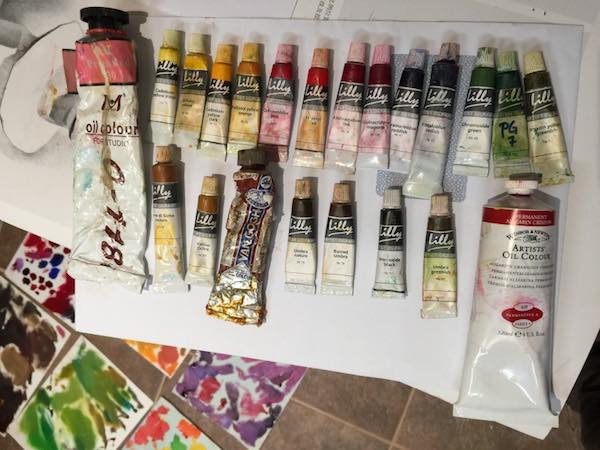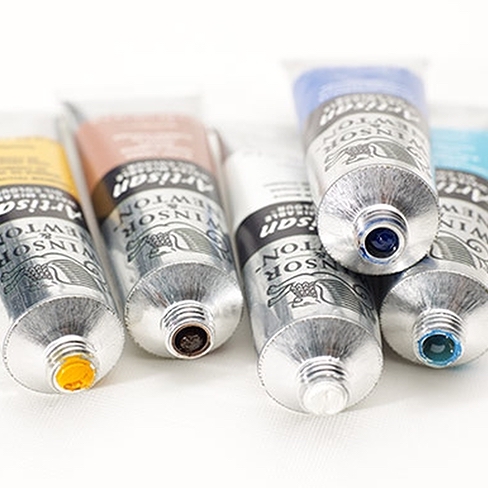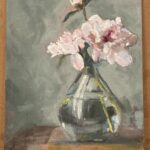(Get free painting tips and plein air painting techniques sent straight to your inbox or on my social media.)
Oils vs Acrylic Paint: How to Choose?

A common question when you start to paint is whether to use oil paints or acrylic paints. Which is the best for beginners? People used to think that acrylic paints were better for beginners, but much of the information about oil and acrylic paints is now out of date. There have been several major developments in the manufacturing of oil paints in recent years that have made oil paints easier to use. So the advice to use acrylics if you are a beginner might not be the right answer. Read on to learn more.
Factor #1: Ease of Clean Up
This used to be the standard criteria for new students. The common wisdom is that oils need smelly and potentially harmful solvents to clean up. However this is no longer true. There is a new type of oil paint called water-soluble oil paint that overcomes this issue. So if you are comparing oils vs acrylic paints this should no longer be an issue.
Conclusion: Not a factor anymore
Factor #2: Problems With Fast Drying Times
Drying time is a very important consideration. The key issue is that if the drying time is too short, you run into many problems.
If your paints dry too quickly, you cannot blend edges very easily. This means you cannot control the hardness or softness of the edges between two shapes.
Now this is important in painting because you need to a mix of both hard and soft edges to make things look three dimensional. Using edges is also very important to control the viewer’s eye around your painting. Hard edges will attract attention. Soft edges will not.
This is a major problem with fast-drying acrylic paints. You will hear about additives you can buy to overcome the problem. But these cause other problems. It is very inconvenient to have to add an additive to your paint every time you use it. Also retarders are likely to change the consistency of your acrylic paint. The basic issue is that acrylic paints are designed to dry quickly.
Conclusion: Oils are a far better choice and have much more flexibility.
Factor #3: Color Shifts When Drying
This is a problem with acrylics. The binder used in acrylic paints is often white but it dries clear. This means your colors will appear lighter when you first paint them but later they will turn darker as the white binder turns clear. This can make it difficult for you to judge values, particularly when you are painting portraits.
In addition, common methods to overcome this limitation, such as adding various mediums (quick dry mediums, flow release medium, and so on), make the color shift even greater. If you use student grade paints that have more fillers added, these color changes will be even greater.
Conclusion: Oils are a better choice. Color shifts can make judging colors with acrylics tricky.
Factor #4: Drying Time when Traveling
When you are traveling, drying time is important.
Acrylics: These are great for traveling because of their very fast drying time. This makes acrylic vs oils rather easier to manage when you are traveling.
Oils: If you want to travel with oils, you can use an alkyd medium or use alkyd white instead of normal white. This will help your paintings dry faster. They will dry in one day in a hot climate, or two days in a cooler climate using this technique. The other solution is to use drying boxes or panel carriers. These are boxes or frames that will keep your paintings from touching each other or another surface while they are still drying. However when traveling, oils you will have to do a little more preparation than with acrylics.
Conclusion: Acrylics are an easy choice, but you can still use oils with some preparation.
Common Myths About Oils vs Acrylic Paint
Myth #1: You get mud when blending
It is often said is very easy to mix ‘muddy colours’ when starting with oils due to everything staying wet and the colours mixing together on the canvas. This is simply not true.
The key to not getting muddy colors has nothing to do with the colors mixing together. It has everything to do with using the wrong colors in the first place. Usually the problem is a value problem: trying to blend colors of different values. This will create mud if the temperature of the colors is incorrect.
To successfully blend colors you need to gradually change the temperature of the colors you are mixing. The simple way to do this is having a gradual transition across the color spectrum. Change the color gradually from red, orange, yellow, green, blue, to violet will often avoid your colors getting muddy.
Note: Although this is a simple rule, there are other factors too complicated to go into in this article. Good color is not a simple thing, and depends on a lot of experience and practice.
Conclusion: Not a factor
Myth #2: Oil colors are not stable over time
It is often said that oil colors are not stable over time and gradually yellow. This is actually quite true. However the effect is small that it is of no consequence to the beginner painter. Even for professional painters this is hardly an issue. Often the yellowing is caused by leaving the painting in the dark for long periods of time. There is a solution to this: you can reverse the yellowing by leaving the painting exposed to light. See https://www.justpaint.org/what-is-dark-yellowing/
In practice, most professionals use oil paints and this is not a factor most professional painters consider. So just don’t worry about this.
Conclusion: Not a significant factor
Myth #3: You have to use acrylics if you want to paint thickly
If you like the idea of using using thick juicy paint (like I do often), both oils and acrylics are a good choice. However the technique is different.
Oil painting tip: Remember that if you paint one thick layer over another, in the underlying layer the outer surface will appear dry to the touch but it still be wet underneath. If you do this make sure you add a little more oil to the later layers to slow down the drying. You always want the lower layer to dry faster. See the fat over lean principle.
Oils: With oils you have to be careful about putting one layer on top of another.
If you want to paint one thick layer on top of another you need to let the underlying paint dry. There is a way of doing it without letting it dry, but it takes some skill. If you want to paint a thick layer over a thin layer (a good practice artistically), use a siccative. The easiest way is to just add a little Liquin to the first layer. This way it will dry very quickly.
Cobalt drier used to be recommended. However it is sometimes not recommended for fine art use, and easy to overuse.
Acrylics: With acrylics you can just let one thick layer dry, then paint over it with another thick layer. There is no issue with cracking over time.
Conclusion: Not necessarily a factor, although acrylics will be easier because of the faster drying time.
Oil vs Acrylic Paint: Summary
With all of this discussion, I have summarized all of the considerations for oil vs acrylic paint, into this very simple decision table.
| Factor | Oils | Acrylics |
| super easy when traveling | ✔︎ | |
| best artistic result | ✔︎ | |
| ease of painting | ✔︎ | |
| building up lots of layers of thick paint | ✔︎ |
Thank You
Thank you for taking the time to read this article. I hope you find it useful. If you would like to get free painting tips by email, please sign up for my free tips newsletter.
If you are interested in a structured approach for learning how to paint, take a look at my online painting classes.
Happy painting!
Barry John Raybould
Virtual Art Academy

























Add comment